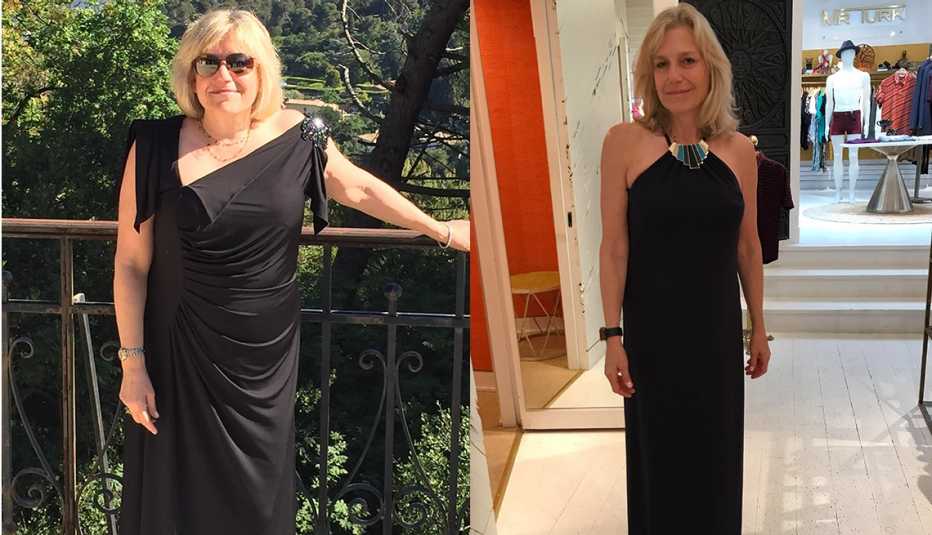Staying Fit


About half of all Americans who are overweight or obese are actively trying to lose weight, according to a study published last year in the medical journal JAMA. But while it may seem daunting, especially if you’re over age 50, it’s eminently doable. Check out these five inspiring stories from men and women who successfully shed weight in their 50s, 60s and beyond.


AARP Membership— $12 for your first year when you sign up for Automatic Renewal
Get instant access to members-only products and hundreds of discounts, a free second membership, and a subscription to AARP the Magazine.
Sherry Greenwald, 57
Cliffside Park, N.J.
Pounds lost: 42
What spurred her to lose weight: her health. Greenwald had always been active and healthy, but as she got older and put on weight, she developed high cholesterol and prediabetes. But what really galvanized her efforts was seeing a photo: “I went to a wedding in the south of France, and when I looked at the picture of myself, I was mortified,” Greenwald recalls. “I’d never thought of myself as being overweight, but I looked heavy and aged.”
How she did it: Greenwald worked with New York City dietitian Tanya Zuckerbrot, MS, RD, author of The F-Factor Diet and The Miracle Carb Diet. One of Greenwald’s problems was that she was on the road all day as a saleswoman, so she often wouldn’t eat until about 4 p.m. — and she’d continue nonstop throughout the evening. Now she eats three meals a day with two snacks, which could be simply a protein bar or a handful of high-fiber crackers topped with peanut butter or chicken. “I found that having these small, frequent meals, each of which had protein and fiber, was really key in keeping hunger in check,” she says. “I especially noticed that days when I skipped my midafternoon snack, I was starving in the evening and much more likely to overeat.”
What seemed hard for about a minute: getting 35 to 40 grams of fiber every day. “That was a big challenge at first, but now I just add vegetables whenever I can — I throw mushrooms and onion and spinach into an egg white omelet in the morning, have a huge salad topped with chicken for lunch and have a grilled lean meat with plenty of steamed veggies for dinner,” she says.
Stay-in-shape tip: Scale back a bit. Greenwald went from doing five hours of cardio a week to simply doing a mix of cardio and weight training twice a week with a trainer. “All that cardio ended up stimulating my appetite, so I ate more and basically negated any calories I burned off,” says Greenwald. She also tries to walk as much as possible for additional exercise.
Motivational tip: Keep living your life. Due to Greenwald’s work, she’s dining out most nights, something she thankfully hasn’t had to scale back on. “I’m very specific when ordering at restaurants — a piece of grilled salmon or steak with no butter or oil on it, steamed veggies on the side and a house salad with balsamic vinaigrette,” she says. Greenwald’s weakness is alcohol, which she indulges in with either a glass or two of red or white wine or a club soda and vodka. “I find that if I treat myself to a couple drinks, I’m much less likely to slip up and order dessert,” she observes, laughing.


Arlene Howard, 70s
Los Angeles
Weight lost: 15 pounds
What spurred her to lose weight: “Professionally, I have to look the best I can,” says Howard, who has been running her namesake public relations firm since 2002. “I have to be alert, on my toes and very fashionable — and I didn’t feel that way when I was carrying around extra weight.” The real turning point, however, was when she saw photos of herself taken last year, on vacation in Hawaii or with clients in Los Angeles. “I just looked so aged and so tired,” she observes. “It was a real wake-up call that I needed to start a healthy eating regimen … not a diet but definitely a lifestyle.”
How she did it: “I just decided to give up sugar,” Howard reveals. “I gave up my beloved cakes, candies and chocolate and replaced them with very sweet fruits, like pineapple or berries,” she says. The first two weeks were tough, and Howard found herself constantly craving ice cream and sugar-sweetened yogurts. But within a few weeks, “the desire to eat these types of foods just disappeared, and I was fine.” Other than that, Howard didn’t restrict calories at all. She ate plenty of fresh fruits and veggies as well as lean protein such as chicken and fish. Breakfast is typically oatmeal sprinkled with raisins and walnuts, paired with either an egg or chicken sausage. Lunch is last night’s leftovers, which is often chicken, veggies, plus a piece of fruit, and cheese. Dinner is a lean protein like turkey meatballs, accompanied by veggies and half a glass of wine. “I mix it with mineral water and it gives me a sense of sweetness to enjoy with my meal, as well as a feeling of sophistication and elegance,” she says. When she feels the urge to snack, Howard munches on fruit and nuts, such as almonds. “A couple months ago, I decided to give up wheat, too, since it made me feel bloated, and although I haven’t lost any more weight, I feel like I have much more energy,” she adds. She also makes sure she’s in bed by 9:30 most evenings. “If I’m asleep, I don’t have the chance to indulge in late-night snacking,” she says with a laugh.


































































More From AARP
8 Things to Do at 50+ to Help You Live Longer
It’s never too late to make small changes to improve your health
What Men Wish Their Doctors Told Them About Turning 50
5 health changes you might not expect and what to do about them
How Healthy Are Your Cooking and Eating Habits?
See how many of these practices you already use